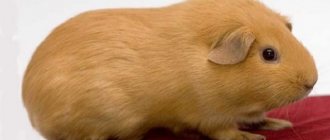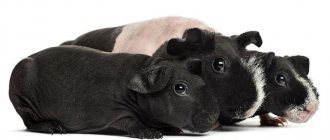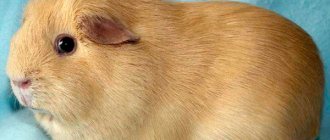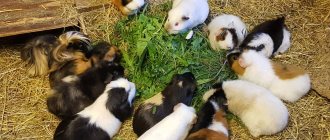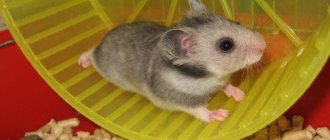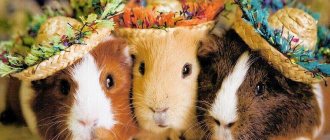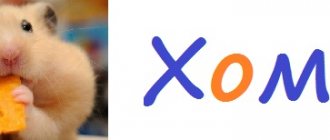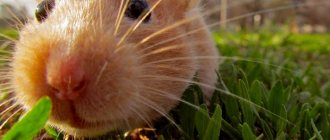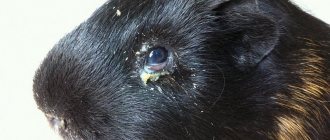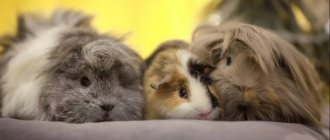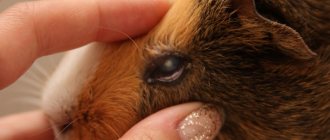Description and appearance
The appearance of long-haired guinea pigs differs from short-haired representatives of the breed in the length of their coat. In the former, the length of the curls reaches 20–50 cm and sometimes covers the entire muzzle. And in terms of body structure and size, they are no different from their short-haired relatives.
The weight of pigs is 1.5 - 2 kg, body length is about 30 cm. Life expectancy is about 10 years, puberty occurs by the 10th month from birth. Pigs come in different colors, the most common being red.
The character of long-haired rodents is calm. These are sociable animals that regularly require communication either with their owners or with relatives. They get along well with other pets.
Long-haired breeds include:
- Peruvian;
- Sheltie;
- alpaca;
- coronet;
- texel.
Shorthair breeds
The second name for this large group of rodents is smooth-haired. Representatives of this population can most often be found among ordinary people; animals are no less popular in scientific circles, where they are used as experimental animals.
All breeds in this category are characterized by the presence of smooth, even coat; the hairs fit tightly to the body. According to the type of color, they are divided into plain and variegated.
- Ordinary. In appearance it resembles a ball, it is so compact and stocky. The eyes are round, large, and black. The ears are set wide apart, hang down, and have no hair. The color can be any, mainly spots of black, white, and red are scattered throughout the body. There are also single-colored individuals.
- Self. Characterized by uniform coloring of the entire fur coat. At the same time, there can be a great variety of color variations: albino, black, gold, red, cream, saffron, purple. Eye color - black or red. The hair grows back, the “hairstyle” is always neat, like a real English queen.
- Satin, in other words - satin. The charm and beauty of these pigs lies in the incredible shine of their hair, which is especially pronounced in the spotlight or in the sun. In principle, this type can be classified in the previous group of monochromatic ones, because the difference lies only in the structure of the hair - in “satin” it is hollow inside, which is why it shimmers in bright light.
- Russians. Sometimes pigs are also called Himalayan, although they have nothing to do with the Himalayas and were bred in our country. The peculiarity of the “piglets” is their snow-white body with black (chocolate) paws, ears and muzzle. This coloring appears well in cool climates, but if the ambient temperature is too high, the pigment will lighten and the animal will be completely white.
- Motley. Not one breed, but includes several.
- Dutch. It is distinguished by its unusual color, characterized by the presence of dark spots on the cheeks and the back half of the body. In this case, the white spot on the muzzle should have the shape of a regular wedge. The Dutch weigh slightly less than their relatives, have a soft, easy-going character and get along well with children.
- Agouti. The most common species are golden and silver. There are also chocolate, cream and brown. Each hair is divided into three color zones, while the abdomen is monochromatic. The breed is considered one of the hardiest and most prolific. By the way, there is an opinion that agouti are the progenitors of all currently available breeds of pigs.
- Speckled. Alternating black and red stripes throughout the fur coat. The latter look like spots with a clear separation boundary. Sometimes there are variations of the three-stripe color, when white is also added.
- Tortoiseshell. The presence of clear spots of black, red and white colors, alternating in a special order. At the same time, the fur coat looks like a patchwork quilt or even a chessboard. By the way, in Russia these rodents are often called “cakes”, which is similar to the English name of the breed - torty&white.
Lifespan
On average, pig-like rodents live about 5 years. With good care, the pet enjoys a life of 6 to 8 years. Sometimes especially lucky pigs live up to 10 years.
The short life expectancy is compensated by incredible fertility. 15 hours after giving birth, the female is ready to mate again as she goes into estrus. The offspring usually consists of 9 or 10 individuals. Thus, one individual can bring up to 100 babies per year.
Frequent births are not good for the animal, so it is better not to allow the female to give birth more than 2 times a year.
Nail trimming
In addition to taking good care of your teeth, an important element of caring for your guinea pig is keeping its claws in good condition. The point is to ensure that they do not grow too long, as this would make it difficult for the animal to move. In bred guinea pigs, the claws do not wear off on their own sufficiently, so the owner is obliged to help them with this. However, this should be done very carefully and only when absolutely necessary. In this case, another person is needed to care for the animal. The most suitable tool is sharp special scissors or nail trimmers.
Excessively long claws are shortened with special scissors or claw tongs, taking care not to damage living tissue. A slight excess of the length of the incisors is eliminated using a nail file, and very long teeth are trimmed with sharp special scissors. However, if you have never performed this type of operation before, have it done by an experienced person.
Pay attention to the blood vessels. You cannot cut the claws too short, because the upper parts contain nerves and blood vessels. Damage to this living tissue causes excruciating pain to the animal, the wound takes a long time to heal, and chronic infection can occur as a complication. In a situation where living tissue is damaged, it is necessary, first of all, to stop the bleeding using a constrictor (for example, lapis bacillus), and then take care of cell hygiene as much as possible in order to prevent infection.
Rodents' nails are trimmed at approximately 1 year of age, and then 1-2 times a year. In nature, they wear down naturally on sand and stones, but at home they grow excessively, which brings discomfort and pain to pigs.
The cut should correspond to the profile of the claw. To prevent the claws from crumbling, you should use special tweezers (can be purchased at a pet store).
The claws must be trimmed carefully. It is better to do this in front of a “backlight” lamp, so as not to make a mistake and damage the blood vessels. It is easy to recognize the place to which a claw can be trimmed in light-colored animals. Examining the claw in the light, you will see translucent blood vessels; Circumcision is allowed only within the transparent area. To do this, you need special scissors or nail trimmers. During this procedure, you need to hold the pig carefully, but firmly - it will try to tear its paw out of your fingers. And one more thing: try to ensure that the cutting edge is located across the claw. It may crack if cut at an angle.
If the claws are dark, it is very difficult to determine the location of the blood vessels. In this case, this procedure should be carried out by two people: one holds the guinea pig and illuminates the claws from below with a spotlight, the other trims them.
Keeping and caring for a long-haired guinea pig
Before buying a pet, you should choose a home for it. A cage or enclosure is suitable for pigs. If the pig will live in a cage alone, then its size should be at least 60x60x40 cm. Enclosures are usually more spacious, the main thing is that the height of the walls of the enclosure is at least 40 cm.
Aquariums or terrariums are used to keep pigs. But for long-haired pets this type of housing is least suitable. Voluminous fur and the lack of constant air circulation create unbearable stuffiness for the pet. Therefore, it is better to house a pet with long hair in lattice cages or enclosures.
Place the pet’s housing in a room with a temperature of about 20 degrees and humidity of 50%. Animals react poorly to overheating and hypothermia, so the place for housing must be chosen carefully. It is not recommended to place the cage near a window, radiators, in aisles or corridors.
In a cage or enclosure it is necessary to install a tray, a feeder, a drinking bowl, a hay box, a house for sleeping and other toys and accessories at the request of the owner and the interests of the pet. The bottom of the cage is sprinkled with filler, compressed sawdust or soft hay. To grind down the animals' teeth, a salt stone and branches of fruit trees are left in the cage.
Feeders and drinking bowls need to be cleaned regularly. The tray is cleaned 2 times a week, but if there is an odor, this can be done more often. The entire cage with “furniture” is washed once a month, using special cleaning products that are safe for pigs.
For physical development, pigs are allowed to walk around the apartment every day. Before going for a walk, you need to ensure the safety of the walking area. To do this, remove dangerous objects, close cracks and warn everyone in the household that a small pet is on the loose.
To make the fur less tangled during play, and to make it easier for the pet to move, it is better to braid the animal’s hair in curlers. In some breeds, the fur completely covers the muzzle, which makes it difficult to monitor the condition of the eyes. In this case, breeders advise braiding the bangs into a ponytail on the top of the head.
Caring for long-haired pigs takes more time and effort than caring for their short-haired cousins. One of the main concerns of owners is the chic hair of their pet. The coat needs to be groomed daily. Every day you need to comb the animal’s fur with a special soft brush so that tangles do not form in it. Mats pose a serious health hazard to your pig. Hairballs disrupt thermoregulation, they disturb animals, and they begin to chew them. In this case, animals can ingest fur and get indigestion. Therefore, the tangles that have formed must be cut off, since combing them out will cause pain to the pet.
If the coat is too long, it can be shortened. But if the animal participates in exhibitions, then the fur cannot be trimmed. Water procedures are performed as needed: if the pet is dirty or has an unpleasant odor. After bathing, you need to check your pig's ears. If there is sulfur in them, it must be removed with a cotton swab or cotton swab.
The wool is slightly moistened before combing. This makes it easier to comb and reduces discomfort for your pet. To care for the coat, you will need a soft brush and comb. The brush allows you not only to comb the hair, but also to massage the skin. This procedure will bring pleasure to your pet. A comb is needed to prevent tangles.
Regular care includes not only combing, but also checking the skin for lice, other parasites and skin diseases.
The diet of pigs with long hair is no different from that of other pigs. They eat hay, grain, grass and vegetables. It is better to collect herbs for pigs deep in the forest and away from roads and various industries. The settling of burning fumes and exhaust gases can cause poisoning in pets. For long-haired animals it is important to receive a varied and high-quality diet. The condition of the coat depends on the pet's diet. By treating your pig to a variety of vegetables, leafy vegetables, fruits and berries, adding grain mixtures or dry food, you can count on silky fur. Ideally, your pig's diet should include at least three types of vegetables. Every day you need to give your pet raspberry or currant leaves, and in winter you should always leave dry grass in the nursery.
The main sign of an animal's illness is refusal to eat. In a healthy state, animals eat at least 3 times a day, usually more often. If your pet shows no interest in food during the day, then most likely he is sick.
Nail trimming is part of monthly exercise. Animals need to have their claws trimmed to prevent them from growing long and curling. Irregular nail trimming leads to deformation of the pet's skeleton, the formation of fungal diseases and tangled fur.
Introduction
In recent years, it has become fashionable to purchase various animals for apartment keeping, which, it would seem, can be positive for the development of an environmentally friendly society, but in the absence of experience and free time it leads to the fact that the pet, despite the “honest” care of the owner, is not comfortable.
I would like to have a beautiful, tame, affectionate animal and take care of it in my free moments.
The ideal companion for very busy and always free people, children and adults, is the Peruvian long-haired guinea pig. The animals are very affectionate, with a rich sound repertoire.
This breed is a wonderful work of art of many generations of breeders, has a unique breed appearance, and is very easy to keep [2].
Pigs of this breed were brought to Russia in the last century; the centers of their selection were and remain Moscow and Lipetsk; there are a small number of good nurseries in St. Petersburg [2].
Angoras were repeatedly brought to the city of Kemerovo, but no serious selection was carried out. As a result, we find the “long-haired” gene in many local individuals, and true breed specimens are rare[2].
There is no literature clearly stating the standard in Russia, but the leading breeders in our country have a very clear idea of the breed. The presented report is an analysis of domestic literature and literature translated into Russian, information received from nursery owners, long-term observations of Peruvian long-haired guinea pigs in the creative association of the GorSYUN "Fauna" based on school No. 92 in Kemerovo.
Purpose: To study the features of the exterior and behavior of the Peruvian long-haired guinea pig, based on the information received, to give recommendations on the maintenance of this breed.
Tasks:
- Get a clear idea of the current state of the breed and trends in its development.
- Outline the behavioral characteristics of the breed.
- Based on the knowledge gained, make recommendations for the care and maintenance of the Peruvian long-haired guinea pig.
Source
Owner reviews
Breeders of pigs with chic hairstyles say that these animals require careful care. Their character is also called difficult. They are picky eaters and have a hard time with hygiene procedures.
Rodents are quite voracious. If there is no garden, feeding a pet will cost about 4,000 rubles. Additionally, you need to visit a veterinarian.
Breeders warn that long-haired pets shed all year round. This means that hair from the animal will need to be removed regularly, or it will be everywhere.
Research and conclusions
In the city of Kemerovo, hobbyists keep single specimens of long-haired pigs, the origin of which is unknown; semi-long-haired individuals are found in huge numbers, but it makes no sense to consider their exterior in this topic. Therefore, we will consider the best guinea pigs of the Peruvian breed, kept in the corner of nature of GorSYUN, where there is the largest population of purebred animals in the city. The origin of almost all the animals from “Fauna” is known, and many carry the blood of European champions.
Breeds of pigs with long hair
Angora breed
The Angora pig is distinguished by large bones, a wide neck and head. They have an even distribution of hair growth. Angoras have rosettes on their foreheads and near their eyes. Particularly valuable are individuals that, in addition to them, have small rosettes at the nose. The length of the angora's fur reaches 20 centimeters. Long bangs cover the entire muzzle. The weight of individuals is up to 850 grams.
Individuals with a parting on the back, too soft or short fur, asymmetrical rosettes, short sideburns or growing downwards do not meet the breed standards and are rejected.
Peruvian breed
Representatives of the Peruvian breed reach a weight of up to one and a half kilograms, a body length of up to 40 cm. The length of the coat reaches 50 centimeters. These animals have a parting on the back, rosettes near the sacrum. A large rounded body, a wide shoulder girdle, but a small head distinguish the Peruvian breed from others.
The history of Peruvian rodents in Europe begins at the beginning of the 19th century. At this time, pigs were imported from South America. “Peruvians” were rare among other representatives of pigs, so they were expensive. In the first half of the 20th century. The breed was assigned its own standards, and the whole world learned about it.
Pedigree individuals have shorter hair on their paws and belly. The breed standard does not allow a train of different lengths, parting on the back, lack of undercoat, the presence of fine hairs, the formation of curls and bald spots.
Breeders claim that representatives of this species have a calm and quiet character, are unpretentious in their diet and love communication.
Alpaca guinea pigs
The alpaca breed was developed by crossing a Peruvian pig and a rex. American scientists were involved in developing a new breed.
The name of the breed is due to the similarity of the coat of the artiodactyl alpacas and the pigs of this breed.
The length of alpaca wool reaches 30 cm, weight up to 1 kilogram, body length up to 20 cm.
Alpaca wool has one peculiarity: when it reaches a certain length, it begins to curl, rising upward.
Breed specialists at exhibitions attach particular importance to matching the length of the coat to the age of the animal. To improve the quality of wool, owners use vitamins and other medications. These drugs also affect coat length.
Guinea pigs coronet
The Coronet breed was bred by the Englishwoman Claire Wyeth in the second half of the 20th century. To develop a new breed, representatives of the Sheltie and Crested breeds were crossed.
The name of the animals appeared due to the special growth of fur on the head of the rodent, which is shaped like a circular comb.
The breed was developed by crossing alpaca and Crested breeds about 50 years ago, but was recognized by the professional community and the breed standard was determined only 11 years ago.
Texel guinea pig
These animals have a funny look. Their coat is not the longest among long-haired breeds. But it curls in a special way, which makes their appearance unlike all other breeds of pigs. Caring for their coat is not burdensome, as it is not so long. But in preparation for the exhibition, the animals’ fur must be thoroughly cleaned and combed, since pigs with curls are not allowed to participate in the exhibition.
Texel is the youngest breed among other pigs.
Wirehaired pigs
Their second common name is rosette. The wool is hard to the touch and should form rosettes, with the hair in it spreading from the center of the circle to its circumference.
All “piglets” in this category are characterized by a quarrelsome character, as well as the ability to live in a cool climate. For example, in Europe, many owners keep their pets outside all year round.
The most ancient representative of the group is the Abyssinian guinea pig, which is also called Japanese. The hair should stick out in all directions, be very stiff, no more than 3 cm long. In this case, the rosettes are distributed evenly over the entire surface of the skin and in no case should merge with each other.
The color can be mottled (alternating red and black hair), tortoiseshell or plain.
Conditions of detention
Pigs are sociable and usually get along well with other pets. They are often bred in pairs (preferably same-sex ones if there is no intention of breeding).
A large cage (suitable size for one individual is 60-40-60 cm) with a slatted floor is suitable for keeping - so that waste falls into the tray and does not stain the wool. Dirt constantly sticks to the long fur, so cleaning should be done as often as possible - 4-5 times a week. Wood filler or sawdust is used as bedding.
The pet can be trained to go to a specially designated place when needed (a tray with sawdust in the corner of the cage). In this case, it is enough to thoroughly clean the cage once a week.
Sheltie
The Sheltie guinea pig was obtained by crossing the American and Peruvian breeds. The Sheltie has a straight, long coat, but the main difference is the direction the coat grows from the head to the back.
A special feature of Sheltie pets is their lush mane, which hangs around the animal’s body. Shelties have different colors. It has a dense body, a wide head, a short nose, large and bulging eyes, and slightly drooping ears. The Sheltie's temperament is playful and calm.
